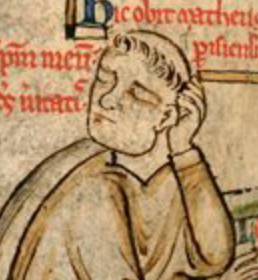Let’s take 10 famous historical historians — one each week — and see what they can achieve with the Bibliography of British and Irish History (BBIH).
The Bibliography is a record of more than 600,000 publications relating to Britain, Ireland and the British world. It’s an essential resource — in many different ways — for every historian, however eminent …
In this episode, we look at how BBIH can help you create and update reading lists for teaching. Useful for you and your students.
Episode 3: Matthew helps Cecilia prepare for teaching

Matthew is a monk at the illustrious abbey of St Albans. He is terribly clever, and is currently working on an ambitious project on the history of the world, provisionally titled Chronica majora. Matthew is confident he is writing a well-balanced account of events, that doesn’t reveal his inner prejudices and loathing of the papacy at all.
Matthew maintains a huge social network. This is for the purposes of acquiring critical historical reports, and definitely not at all for gossip and intrigue. One day, his friend Cecilia de Sanford comes to him in a terrible state. She has been given the task of teaching Eleanor Plantagenet, the daughter of King John and Isabella of Angoulême, about her family history and she does not know where to start.
Fortunately, Matthew knows about the IHR’s Bibliography of British and Irish History, and what a vital tool it can be, particularly when assigned a teaching module you’ve never taught before at short notice.
Cecilia needs to get Eleanor up to speed on the family history of the Angevins, so that she doesn’t embarrass herself at court. Matthew shows her how to search on royal families, adding further filters such as ‘place’ and ‘date’. All of the material on the Bibliography is checked by academic section editors, so she can be sure they are all reliable resources.

Cecilia has an extremely productive afternoon, compiling resources that cover the key family connections of the Angevins in England since 1154. She now has a clear outline of how she can structure her teaching sessions. Thanks to BBIH, Cecilia can also draw up a reading list for Eleanor so she too can do some background reading. Unfortunately, much of Eleanor’s family’s short history in England has been full of rebellion, betrayal, murder, abandonment and war, and Cecilia hopes that Eleanor’s future is a lot less eventful (spoiler: it is not).

After a few hours, Cecilia has everything she needs to get started, and is thoroughly competent in using the Bibliography. She knows now that if any further history teaching is required, BBIH will be her first port of call. ‘Oh look’, she says to Matthew, ‘there’s a review here of your recent work. It says you are really mean to the pope’.
Matthew pretends not to hear and carries on drawing his map.
Find out what happens with our next historian in episode four – available next week on the IHR blog!
Previous episodes:
Episode 1: Bede and the Bibliography
Episode 2: Gerald goes to Ireland
About Matthew Paris …

Matthew Paris was a Benedictine monk (c. 1200–1259). He entered the abbey of St Alban’s in 1217, where he worked under abbot and historian, Roger of Wendover. When Roger died, Matthew took on the Chronica majora, a universal history of the world from creation to the year 1253. He also wrote many hagiographies and local histories.
About the Bibliography of British and Irish History …

The Bibliography of British and Irish History (BBIH) is the largest and most comprehensive guide available to what’s been written about British and Irish history, from the early 1900s to 2019.
It’s an essential resource for research and teaching, providing up-to-date information (and links) to more than 610,000 History books, articles, chapters, edited collections and theses. Currently 108 resources relate to Matthew Paris.
New records are added in three annual updates. These records are searchable by a wide range of facets including: title, author, chronology, date and form of publication, historical topic and geographical region.
The Bibliography is a research project of the UK’s Institute of Historical Research and the Royal Historical Society, and is published by Brepols. BBIH is a subscription service and is available remotely via university and research libraries worldwide.
For more on using BBIH to create reading lists and how to help in your teaching, please see another of our blogs from earlier this year.



